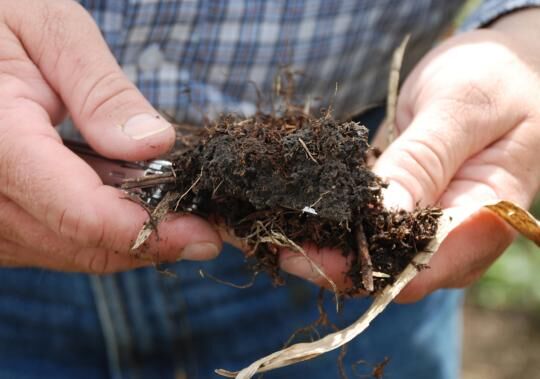Study looks at role soil organic carbon plays in improving soil health, reducing drought

A new peer-reviewed research report published by the Soil Health Institute provides fresh insights into the vital role that soil organic carbon levels can play in preventing drought, reducing flooding and improving the health and water retention of the soils used to grow crops.
The publication includes the development of new pedotransfer function equations, available for use by other researchers, that enable more precise measurement of the correlation between carbon levels, water retention and various soil types. These new equations will allow scientists to better predict how much water farmers can provide to their crops through improved soil health—specifically, by raising their soil carbon.
According to SHI, the global non-profit charged with safeguarding and enhancing the vitality and productivity of soils, healthy soil that is rich in carbon acts like a sponge to soak up rainfall and store it for crops. While farmers have known this for a long time, it has been hard for scientists to predict how much extra water farmers can expect when they use regenerative agriculture practices that improve soil carbon. This is important because many farmers consider water management to be the biggest reason to adopt soil health management practices like no-till or cover crops.
“A positive, causal relationship between soil organic carbon and plant water-holding capacity has direct benefit by increasing crops’ resistance to drought,” said Dianna Bagnall, a soil research scientist with SHI and lead author of the study.
According to Bagnall, previous research on this relationship has been mixed, with some findings showing negligible impact on soils’ water-retention capacities from higher soil carbon levels while others showed a substantial increase in water holding. This new study took a different approach, drawing on a more comprehensive sample of soil from locations throughout North America, using more natural, preserved soil structures, and identifying levels of calcium carbonate, which can impact water-holding capabilities, in the soil samples as part of its analysis.
“Our findings showed an increase in water-holding capacities for non-calcareous soils (those lacking calcium carbonate) resulting from soil organic carbon that was more than double that of earlier studies,” Bagnall said. “This is an exciting development, since it provides a concrete incentive for farmers to adopt more responsible soil management practices that will positively impact their productivity and profitability.”
To help farmers evaluate the impact carbon sequestration and other practices might have on their businesses, SHI is developing a decision support tool. “The new SHI tool will allow farmers to review various management practices to achieve a targeted increase in available water-holding capacity and better drought resilience in their soils,” Bagnall said.
The complete SHI study, entitled “Carbon-Sensitive Pedotransfer Functions for Plant Available Water,” can be accessed at https://acsess.onlinelibrary.wiley.com/doi/abs/10.1002/saj2.20395.
The new equations discussed in the study are freely available for use by other scientists.
“Our hope is that other scientists and conservationists will build on this work to develop new models for how soils can offset carbon emissions and make agriculture more drought resistant,” Bagnall said.



